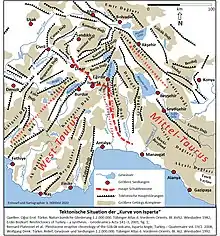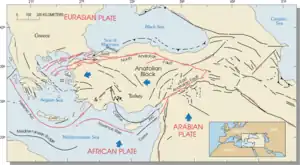Isparta Angle
The Isparta Angle is an inverse-V-shaped morphotectonic structure located in southwestern Anatolia, to the north of the Gulf of Antalya.[1]: 33 Formed by the intersection of the Aegean and Cyprian tectonic arcs,[1]: 32–3 and located between the continental Bey Dağları and Anatolian blocks,[2]: 134 the Isparta Angle is a geologically complex area with many nappes of diverse ages and origins that were pushed onto the Menderes-Tauride platform.[3]: section 2 The Isparta Angle is a result of the Anatolian Plate's rotation from the early Paleocene to the early Pliocene.[4] This is a very seismically active area.[4] It is "characterized by a series of grabens and horsts" separated by active faults.[3]: abstract


Several sediment basins formed in the Isparta Angle during Oligocene and Neogene times as a result of episodic closures of the Neo-Tethys.[3]: section 2 From west to east on the south side, these include the Kasaba-Korkuteli Basin (on the western edge of the Isparta Angle), the Aksu Basin and Köprüçay Basin (both in the angle's "southern core"), and the Manavgat Basin (located on the eastern edge).[3]: section 2 Of these, the Aksu, Köprüçay, and Manavgat Basins together make up the Antalya Basin.[1]: 33
On the north side, the basins include the axial Tauride molasse basin as well as the Çameli, Acıpayam, Karamanlı, Burdur, Isparta, Senirkent, Dinar, Dombayova–Sandıklı, Karadirek, Sinanpaşa, Haydarlı–Karaadilli, the Gelendost, the Beyşehir–Yarıkkaya, the Şuhut, and the Akşehir–Afyon basins.[3]: section 2 Other features in the "northern core" of the Isparta Angle include the Yalvaç, Gelendost, and Eğirdir–Kovada grabens.[3]: section 2
References
- Üner, Serkan; Özsayın, Erman; Dirik, Kadir; Ciner, Attila (January 2018). "Reconstructing the sedimentary evolution of the Miocene Aksu Basin based on fan delta development (eastern Mediterranean-Turkey)". Turkish Journal of Earth Sciences. 27 (1): 32–48. doi:10.3906/yer-1705-21. Retrieved 13 February 2023.
- Poisson, André; Orszag-Sperber, Fabienne; Kosun, Erdal; Bassetti, Maria-Angella; Müller, Carla; Wernli, Roland; Rouchy, Jean-Marie (May 2011). "The Late Cenozoic evolution of the Aksu basin (Isparta Angle; SW Turkey). New insights". Bulletin de la Société Géologique de France. 182 (2): 133–48. doi:10.2113/gssgfbull.182.2.133. Retrieved 10 February 2023.
- Koçyiğit, Ali; Gürboğa, Şule; Kalafat, Doğan (2012). "Nature and onset age of neotectonic regime in the northern core of Isparta Angle, SW Turkey". Geodinamica Acta. 25 (1–2): 52–85. doi:10.1080/09853111.2013.839126. S2CID 129043690. Retrieved 15 February 2023.
- Şahin, Şakir; Abubakar, Ibrahim; Özçelik, Mehmet; Abdelwahed, Mohamed Farouk; Oksum, Erdinç (2019). "Neotectonic structures imaged by seismic velocity along the Isparta Angle". Arabian Journal of Geosciences. 12 (7). doi:10.1007/s12517-019-4377-1. S2CID 135062930. Retrieved 10 February 2023.